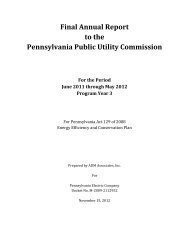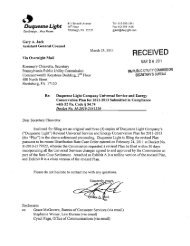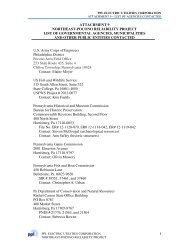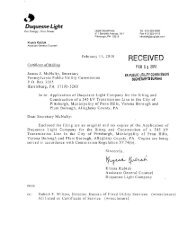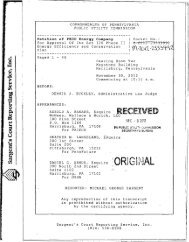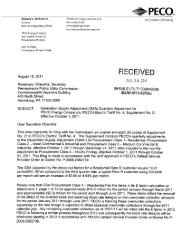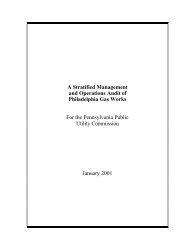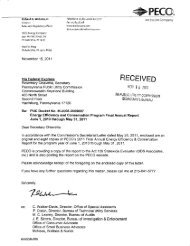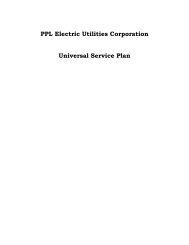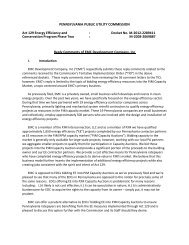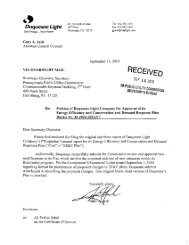2009 Report - Pennsylvania Public Utility Commission
2009 Report - Pennsylvania Public Utility Commission
2009 Report - Pennsylvania Public Utility Commission
Create successful ePaper yourself
Turn your PDF publications into a flip-book with our unique Google optimized e-Paper software.
Section 4 - Conclusions<br />
Conclusions<br />
<strong>Pennsylvania</strong> continues to benefit from a high level of electric service<br />
reliability. The <strong>Pennsylvania</strong> outlook reflects the regional assessment of RFC.<br />
RFC reports that there is sufficient generation, transmission and distribution<br />
capacity in <strong>Pennsylvania</strong> to meet the needs of electric consumers for the<br />
foreseeable future. RFC anticipates that its reserve margin target will be satisfied<br />
through 2012, provided that proposed generation projects will be completed in a<br />
timely manner and enhancements to the transmission network will be capable of<br />
reliably delivering those resources. Summer reserve margins in RFC range from a<br />
high of 20.6 percent in 2008, declining to 8.9 percent in 2017. In 2013, additional<br />
capacity resources will likely be needed to maintain adequate reserves.<br />
The 2008 PJM reserve margin for existing capacity resources was 26.2<br />
percent. Reserve margins are expected to meet the 15 percent reserve margin<br />
target through 2013.<br />
The <strong>Commission</strong> continues to pursue demand-side management, energy<br />
efficiency and load management programs and technologies to address ways to<br />
encourage customers to reduce their demand. These efforts include the<br />
implementation of Alternative Energy Portfolio Standards and the Energy<br />
Efficiency and Conservation Program. In the long term, this initiative will improve<br />
overall energy efficiency, including energy markets and system reliability.<br />
Furthermore, the implementation of the Alternative Energy Portfolio Standards Act<br />
will serve as a catalyst for the development of alternative energy resources.<br />
Through demand side measures and overall improvements in energy efficiency,<br />
EDCs and all customer classes will benefit from this effort.<br />
* * * * *<br />
To summarize the relevant statistics in this report, aggregate <strong>Pennsylvania</strong><br />
sales in 2008 totaled approximately 148.3 billion kilowatthours, a 0.5 percent<br />
decrease from that of 2007. Residential sales accounted for 34.6 percent of the<br />
total sales, followed by industrial (32 percent) and commercial (30.9 percent).<br />
Between 1993 and 2008, the state’s energy demand grew at an average<br />
annual rate of 1.5 percent. Residential sales grew at an annual rate of 1.8<br />
percent, commercial at 2.5 percent and industrial at 0.5 percent. Average total<br />
sales growth from 2003 to 2008 was 1.4 percent. The current aggregate five-year<br />
projection of growth in energy demand is 1.2 percent. This includes a residential<br />
68<br />
<strong>Pennsylvania</strong> <strong>Public</strong> <strong>Utility</strong> <strong>Commission</strong>




